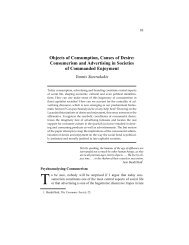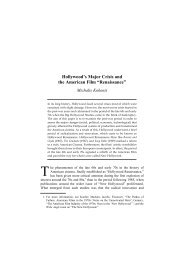19 International Symposium on Theoretical and Applied Linguistics ...
19 International Symposium on Theoretical and Applied Linguistics ...
19 International Symposium on Theoretical and Applied Linguistics ...
You also want an ePaper? Increase the reach of your titles
YUMPU automatically turns print PDFs into web optimized ePapers that Google loves.
G E N E R A L S E S S I O N<br />
The present study was designed <strong>and</strong> c<strong>on</strong>ducted with the aim to provide an account of the issues<br />
related to EFL teachers language awareness, beliefs, <strong>and</strong> misapprehensi<strong>on</strong>s. In particular, the basic<br />
objectives of the study were:<br />
-to identify <strong>and</strong> record the EFL teachers’ current views <strong>and</strong> beliefs about language awareness <strong>and</strong><br />
determine how much agreement there is <strong>on</strong> the matter;<br />
-to specify the EFL teachers’ attitudes to teaching methodologies;<br />
-to reflect <strong>on</strong> the EFL teachers’ attitudes to teaching processes;<br />
-to provide an account of issues related to students’ development of the productive skills;<br />
-to provide an account of issues related to students’ development of the receptive skills;<br />
- to record the EFL teachers’ views <strong>on</strong> the strategies employed by their students in acquiring mastery<br />
of EFL.<br />
Questi<strong>on</strong>naires, which were the basic research instrument, were distributed to a total of 150 EFL<br />
teachers employed in the public school sector in Northern Greece.<br />
The data emanated from the study highlighted the significance of language awareness, which is<br />
metacognitive in nature. The participants acknowledged <strong>and</strong> were c<strong>on</strong>scious of the need for language<br />
awareness in the EFL classroom <strong>and</strong> for training seminars closely related to the issues linked with<br />
pers<strong>on</strong>al c<strong>on</strong>ceptualizati<strong>on</strong> of language awareness <strong>and</strong> the need for reflecti<strong>on</strong> <strong>on</strong> teaching processes.<br />
C<strong>on</strong>cluding, a proposal is made for developing teacher training courses in resp<strong>on</strong>se to the EFL<br />
teachers’ need for devoting more attenti<strong>on</strong> to aspects of teaching methodologies <strong>and</strong> class<br />
management. The need for training linked to the EFL teachers’ establishment <strong>and</strong> maintenance of<br />
professi<strong>on</strong>al st<strong>and</strong>ards has been raised; It involves identificati<strong>on</strong> of the need for teacher knowledge of<br />
the language system, <strong>and</strong> of the importance of developing the four skills. It also includes awareness<br />
activities for teachers in order for them to be able to create <strong>and</strong> h<strong>and</strong>le a wide range of opportunities<br />
for their students’ language learning in an EFL classroom (Tsui, 2003).<br />
The syntax of dem<strong>on</strong>stratives. A parametric analysis.<br />
Cristina Guardiano<br />
Università di Modena e Reggio Emilia<br />
cristina.guardiano@unimore.it<br />
The c<strong>on</strong>tributi<strong>on</strong> proposes an interpretati<strong>on</strong> of the crosslinguistic syntactic behavior of the<br />
dem<strong>on</strong>strative elements within the nominal domain, in a parametric perspective. On the basis of the<br />
empirical evidence coming from a sample of Indo-European <strong>and</strong> n<strong>on</strong> Indo-European languages<br />
(L<strong>on</strong>gobardi&Guardiano 2008), I will show that the different c<strong>on</strong>figurati<strong>on</strong>s available are predictable <strong>on</strong><br />
the basis of the setting of four syntactic parameters (<strong>and</strong> their interacti<strong>on</strong> with other properties) that<br />
determine: the positi<strong>on</strong>s of dem<strong>on</strong>stratives in the DP, their interpretati<strong>on</strong> according to such positi<strong>on</strong>s,<br />
their co-occurrence with the (definite) article. The universal DP structure that I assume has been<br />
sketched <strong>and</strong> defined within the general framework of the ‘DP hypothesis’ (see for instance Bernstein<br />
2001, L<strong>on</strong>gobardi 2001, L<strong>on</strong>gobardi&Guardiano 2008).<br />
Introducti<strong>on</strong><br />
Starting from the fact that ‘all languages have dem<strong>on</strong>stratives’, I will propose a crosslinguistic<br />
definiti<strong>on</strong> of the category, based <strong>on</strong> the following criteria:<br />
a) Semantic features. The semantic properties associated with the dem<strong>on</strong>strative elements bel<strong>on</strong>g to<br />
the ‘definiteness sphere’: dem<strong>on</strong>stratives select referents that are available or deducible from the<br />
extralinguistic (deixis) or linguistic c<strong>on</strong>text (locality).<br />
b) Syntactic positi<strong>on</strong>s. The languages of our database will be classified in a number of different ‘types’,<br />
according to two criteria:<br />
i) the positi<strong>on</strong> of the dem<strong>on</strong>strative with respect to the noun, adjectives, genitives <strong>and</strong><br />
complements of the noun;<br />
ii) its co-occurrence with the definite article.<br />
c) Minimal comparis<strong>on</strong> with other DP-c<strong>on</strong>stituents. The semantic <strong>and</strong> syntactic properties of<br />
dem<strong>on</strong>stratives will be minimally compared with two elements that are typically related to the<br />
‘definiteness/pers<strong>on</strong>’ area, <strong>and</strong> to the D positi<strong>on</strong>: the definite article <strong>and</strong> the third pers<strong>on</strong> pr<strong>on</strong>oun.<br />
Basic positi<strong>on</strong> <strong>and</strong> movement<br />
I suggest that the ‘universal’ positi<strong>on</strong> where the dem<strong>on</strong>strative is generated is in a ‘low area’ of the DP<br />
(where other ‘definiteness’ elements are presumably generated):<br />
D Gen1 Adjs Dem Gen2 NP<br />
The other c<strong>on</strong>figurati<strong>on</strong>s available are predictable as the c<strong>on</strong>sequence of:<br />
<str<strong>on</strong>g>19</str<strong>on</strong>g> th ISTAL 17






